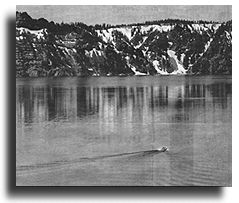Snow postpones Crater boat tours
Mail Tribune
Medford, Oregon
1998
By VICKI GUARINO
A boat creates a wide wake on Crater Lake, known for its spectacular clarity.
Boat tours, interpretive hikes and children’s programs are among the regular seasonal offerings at Crater Lake National Park this summer.
Each year, about a half-million visitors flock to Crater Lake, the deepest in the United States.
Park personnel began clearing snow from the park roads in mid-April, but continuing late season snowfall has been delaying work this year. The project generally takes two months to finish.
The west half of the 33-mile Rim Drive around Crater Lake, and the north entrance, are scheduled to open in late June. Visitors shouldn’t expect the east half of Rim Drive to open before July 15 — more than a week later than usual.
The schedule of lake boat tours will be affected this year by both snow and a major construction project that could close the access trail. Safety and environmental concerns have prompted park officials to install a new fuel-delivery system to boat docks.
Much of the old fuel system was aging and above ground, and presented a risk of a spill in the lake. Plans presently call for the new line to be dug under the dock access trail. Construction can’t begin until snow is gone, delaying public opening of the trail.
A decision on when boat tours might resume isn’t expected until May, so check with park officials before planning a tour. For information, call the park’s visitors center at (541) 594-2211, ext. 402.
Generally, boat tours begin in the last week of June, as soon as snow can be cleared from the trail to Cleetwood Cove, where tour boats are docked. Boats depart regularly from Cleetwood Cove at the bottom of a steep, milelong trail down the volcano’s rim.
On the boats, park rangers describe the geology that makes Crater Lake unique among the nation’s lakes.
With a depth of 1,932 feet, the lake is what remains of Mount Mazama, a huge volcano that erupted 6,850 years ago.
From the boat, visitors can admire the lake’s famous clarity. Depending on wind and water conditions, it’s possible to see to a depth of more than 100 feet.
Boats stop at Wizard Island, a rugged outcrop, and passengers may stay for a hike on the island, then catch a ride on a later boat for the rest of the two-hour tour.
The trail to the boat dock is part of the park’s 140-mile trail system, which links up with the Pacific Crest Trail.
Visitors have a range of options: short walks to check out the wildflowers, longer hikes for panoramic views, to back-country hikes that can take weeks.
A good overall view of the park is atop 8,929-foot Mount Scott. The five-mile trail to the summit begins at the east end of the park off of Rim Drive. The strenuous hike generally takes about three hours. On the summit there are spectacular views of the lake and surrounding countryside.
The trail to Boundary Springs goes nine miles to the headwaters of the Rogue River. The relatively flat trail explores a variety of the park’s ecology on the way. The springs themselves bubble forth from a lush meadow.
Hikers who plan to stay more than a day must obtain free permits from park rangers.
Rangers will begin leading interpretive hikes in the park in July. The hikes, some more strenuous than others, most likely will be conducted daily. Destinations will be somewhat limited early in the season because of snow.
Around the park, snow typically blocks some trails until August.
Rangers pick different destinations each day. Destinations are posted at the visitors center along the rim.
A little earlier — by the end of June — rangers will begin leading daily geology talks at the Sinnot Memorial Overlook just off the rim parking lot.
Every evening at Mazama Campground, rangers give fireside talks on a variety of subjects relating to the lake and its lore.
Talks begin at 9 p.m. until August, when they start at 8:30 p.m. because of the shorter days.
Park rangers will begin offering special programs for children at the end of June. Parents either can join in or take off and leave the children in a ranger’s care for the hour-long session.
Programs about the park and its natural features will be held every day at 5 p.m. in the Mazama Campground.
The programs are geared to youngsters ages 6 to 12. Each participant will receive a Junior Ranger Badge at the end, after meeting the program’s requirements.
Programs will change periodically, so kids may attend several different programs over the course of the summer.
For details about the park, prices, accommodations, and activities, call the visitors center.
Information also is available in the park’s free newspaper, which is handed to visitors when they enter the park. To obtain a copy, write to the information center at Crater Lake National Park, P.O. Box 7, Crater Lake, OR 97604.
Other pages in this section


